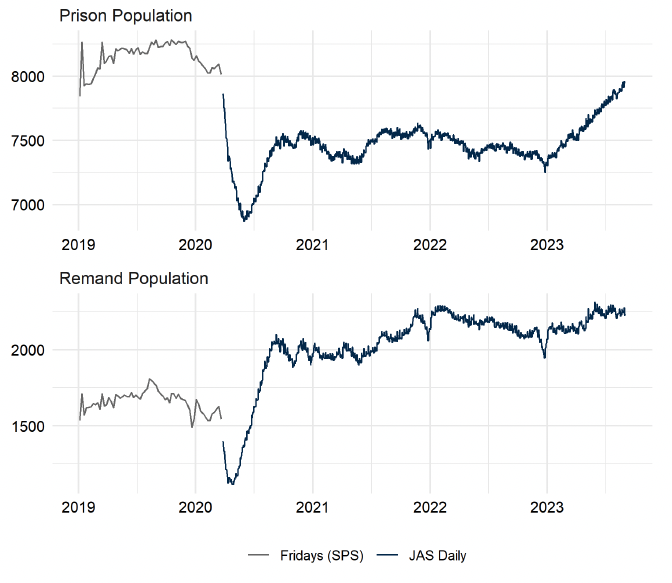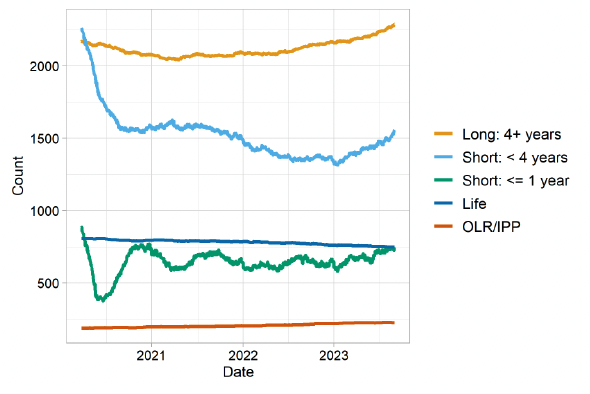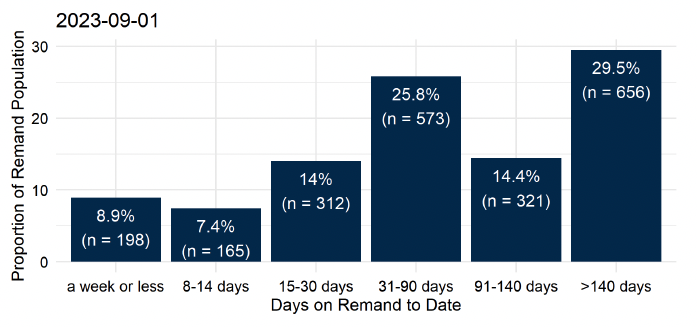Justice Analytical Services (JAS) Safer Communities and Justice Statistics Monthly Data Report : September 2023 edition
This report contains summary statistics covering a number of important justice and safer communities statistics. It is published with up to date statistics every month.
Prisons
Summary statistics on prisons
* New *
- The prison population has risen during 2023
In August 2023 (up until the morning of Friday 1st September 2023):
- the population increased by 67 to 7,954
- 2,225 were on remand: 1,889 (24%) untried & 336 (4%) awaiting sentence. 5,730 (72%) were serving a sentence.
- 62% of arrivals were untried (641 of 1,034), 18% awaiting sentence (190) and 20% sentenced (203)
While the overall prison population continues to be lower than pre-pandemic levels, there has been a sustained increase in 2023 and the number of people held on remand remains at a historic high (see charts below).

Friday population figures published by the Scottish Prison Service, show that the prison population rose from around 7,500 in April 2018 to around 8,300 in November 2019, but fell sharply in the early days of the lockdown in 2020. This was due to a fall in arrivals to custody and the early release of prisoners.
Following a rapid growth in the remand population to September 2020, the prison population stabilised between 7,300 and 7,600 across 2020-22. However, growth across 2023 has led to a higher prison population, reaching a post-pandemic maximum of 7,807 on 28th June 2023. This growth is driven by a rise in both remand and sentenced arrivals to custody. See the Scottish Prison Population Projections for more detail on these changing patterns.
The remand population was at its lowest point of 1,114 on 24th April 2020, but grew to over 2,000 by September 2020. Following a period of relative stability, the remand population has grown further. On 30th May 2023 it peaked at 2,312. People on remand are required by law to be housed separately from sentenced prisoners.
Change in the sentenced prison population varies by sentence length, as shown in the chart below. The populations serving short term overall sentences (less than 4 years) fell substantially and rapidly during 2020, whereas populations serving long term and indeterminate sentences remained at similar levels to pre-pandemic. The population serving life sentences has seen a small and gradual decline since 2020, which has continued in 2023. The population serving sentences of less than or equal to one year increased in the first months of 2023; that population has started to fall more recently. The population serving sentences of one to four years has increased during 2023. Populations serving overall sentences of more than four years, as well as those serving Orders of Lifelong Restriction, have seen continuous increases over a longer period and now exceed pre-pandemic levels.

Time on Remand to Date
* New *
Among the 2,225 people on remand as of the morning of Friday 1st September 2023, the median continuous time spent with this status to date was 73 days.

Note: The remand population includes individuals whose trial has commenced but not concluded, as well as those awaiting commencement of a trial. As a result, the figures referenced above reflect only that an individual has held the same status for an extended period, but do not reflect the relationship between these times on remand and the ongoing court procedure(s) to which they relate.
Remand Arrival Offences
* New *
There were 750 remand arrivals to prison with known offence types in August, awaiting trial or sentence for the following alleged offences.

Note: Double-counting may occur where an individual arrives, is absent from prison for one or more nights in the month, and then returns before the end of the period. Where an individual has multiple alleged offence types in a single stint, the offence towards the top of the list in the chart is used as the index offence.
Contact
Email: Justice_Analysts@gov.scot
There is a problem
Thanks for your feedback